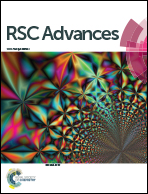Hierarchically porous ternary Au/ZnO@ZIF-8 nanocomposite: spatial in situ Au encapsulation and catalytic activity for the reduction of p-nitrophenol†
Abstract
A hierarchically porous ternary Au/ZnO@ZIF-8 nanocomposite with flower-like morphology has been prepared using a new in situ encapsulation approach. In particular, Au nanoparticles (NPs) were spatially encapsulated from the ZnO surface into the ZIF-8 crystal matrix during its nucleation process. The ternary composite exhibited high catalytic activity for the reduction of p-nitrophenol.



 Please wait while we load your content...
Please wait while we load your content...